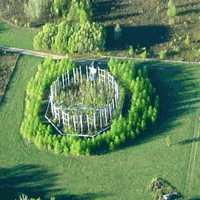
Field experiments using CO2 enrichment: a comparison of two main methods
iForest - Biogeosciences and Forestry, Volume 3, Issue 4, Pages 109-112 (2010)
doi: https://doi.org/10.3832/ifor0545-003
Published: Jul 15, 2010 - Copyright © 2010 SISEF
Review Papers
Collection/Special Issue: NFZ Summer School 2009 - Birmensdorf (Switzerland)
Long-term ecosystem research: understanding the present to shape the future
Guest Editors: Marcus Schaub (WSL, Switzerland)
Abstract
The dramatic increase in global atmospheric carbon dioxide over the past century is hypothesized to have significant impacts on the earth system. To understand the effects of elevated CO2 on terrestrial ecosystems, two main methods have been used to simulate an increase of CO2 in a semi-controlled field setting: 1) Open Top Chambers (OTC); and 2) Free Air CO2 Enrichment (FACE). The OTC method has been applied to study the components of forest ecosystems at small scale by manipulating seedlings or isolated juvenile trees, but is not able to address ecosystem processes as a whole. For technical reasons, OTC cannot be used to consider scaling issues, interaction with the boundary layer, and competition among species. To address these issues FACE technology was developed. FACE enables longer-term studies in larger plots, and allows studies of plant processes such as leaf area and canopy development, canopy energy balance and canopy gas exchange. In this review, I synthesize results from literature, in particular from meta-analysis techniques applied either to OTC or FACE. The results are qualitatively similar: CO2 enrichment leads to reduced stomatal conductance and leaf nitrogen, and enhanced photosynthesis and production. However, photosynthesis and crop yield were lower in FACE experiments than OTC, while starch content was higher. These results provide support for ecosystem model simulations, and help fill the gap between individual plants, forest and regional ecosystem. Neither OTC nor FACE can provide a clear indication of the regional-scale feedbacks between atmosphere and vegetation that might be expected under elevated CO2. To address this issue, further research is needed.
Keywords
Photosynthesis, Free-Air Carbon dioxide Enrichment FACE, Open top chamber, Carbon sequestration, Forest ecosystem
Authors’ Info
Authors’ address
Soil-Vegetation-Atmosphere Research Group Institute for Environmental Science and Technology, Ecole Polytechnique Fédérale de Lausanne, Station 2, CH-1015 Lausanne (Switzerland)
Corresponding author
Paper Info
Citation
Mauri A (2010). Field experiments using CO2 enrichment: a comparison of two main methods. iForest 3: 109-112. - doi: 10.3832/ifor0545-003
Paper history
Received: May 25, 2010
Accepted: Jun 01, 2010
First online: Jul 15, 2010
Publication Date: Jul 15, 2010
Publication Time: 1.47 months
Copyright Information
© SISEF - The Italian Society of Silviculture and Forest Ecology 2010
Open Access
This article is distributed under the terms of the Creative Commons Attribution-Non Commercial 4.0 International (https://creativecommons.org/licenses/by-nc/4.0/), which permits unrestricted use, distribution, and reproduction in any medium, provided you give appropriate credit to the original author(s) and the source, provide a link to the Creative Commons license, and indicate if changes were made.
Web Metrics
Breakdown by View Type
Article Usage
Total Article Views: 59657
(from publication date up to now)
Breakdown by View Type
HTML Page Views: 50833
Abstract Page Views: 3444
PDF Downloads: 4319
Citation/Reference Downloads: 29
XML Downloads: 1032
Web Metrics
Days since publication: 5621
Overall contacts: 59657
Avg. contacts per week: 74.29
Citation Metrics
Article Citations
Article citations are based on data periodically collected from the Clarivate Web of Science web site
(last update: Mar 2025)
Total number of cites (since 2010): 4
Average cites per year: 0.25
Publication Metrics
by Dimensions ©
Articles citing this article
List of the papers citing this article based on CrossRef Cited-by.
References
Available technologies for field experimentation with elevated CO2 in global change research. In: “SCOPE 45 Ecosystem Experiments”, Chapter 15 (Mooney HA, Medina E, Schindler D, Schulze ED, Walker BH eds). Wiley, UK, pp. 296.
Gscholar
FACE technology: Past, Present, and Future. In: “Managed Ecosystems and CO2” (Nösberger J, Long SP, Norby RJ, Stitt M, Hendrey GR, Blum M eds). Springer, Berlin, Heidelberg, New York, pp 15-43.
Gscholar
Fourth Assessment Report. Chapter 10. Global climate projections. 10.7 Long Term Climate Change and Commitment 10.7.1, Climate Change Commitment to Year 2300. Based on AOGCM, pp. 822.
Gscholar
The effects of tree maturity on some responses to elevated CO2 in Sitka Spruce (Picea sitchensis Bong. Carr.). In: “Carbon Dioxide and Terrestrial Ecosystems” (Koch GW, Mooney HA eds). Academic Press Inc., S. Diego, CA, USA, pp 53-70.
Gscholar
CO2 enrichment of a deciduous forest: the Oak Ridge FACE experiment. In: “Managed ecosystems and CO2: case studies, processes, and perspectives” (Nösberger J, Long SP, Norby RJ, Stitt M, Hendrey GR, Blum H eds). Ecological Studies, Springer, Berlin, vol. 187, pp. 231-251.
Gscholar
A U.S. carbon cycle science plan: a report of the carbon and climate working group. U.S.Global Change Research Program, Washington, DC, USA, pp. 69.
Gscholar
The study of ecosystems in the context of global change. The terrestrial biosphere and global change. International geosphere-biosphere programme book series 4, pp 27.
Gscholar
Carbon dioxide enrichment technologies for crop response studies. Journal of Scientific and Industrial Research 65 (11): 859-866.
Gscholar

















